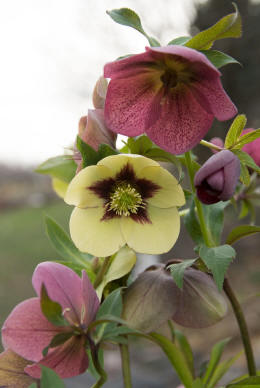
(4/21) Hellebores are ideal plants for a shady spot in a landscape, especially in a woodland garden. It is rewarding to a gardener like me who strives to preserve a four-season garden. It is particularly gratifying to have blooms (which are actually sepals that protect the true flowers) in late winter and early spring. This is when hellebores take center stage. Even
when they get flattened by winter’s harsh snow and frost, they revive with the first warming rays of the sun in spring. I have the utmost respect for a plant that braves whatever nature throws its way and can still show off its flowers. Their range of colors from pure white, yellow, green, pink, plum, and midnight purple are a wonderful display in a garden. Hellebores are
in their full glory for ten to twelve weeks.
Commonly known as Hellebore, the genus Helleborus consists of approximately 20 species of herbaceous or evergreen perennial flowering plants in the family Ranunculaceae. The Ranunculaceae family includes well-known plants such as delphinium, anemone, buttercup and aquilegia. Most of the common hellebores are clump-forming, low growing evergreens with toothed, palmate
foliage.
The most popular and easiest to grow are the Oriental hybrid hellebores (Helleborus x hybridus cvs.). They are USDA Hardy in Zones 5a – 8b. They can reach 18-24 inches in height. Their common name is Lenten Rose because they bloom around the beginning of Lent. They prefer being planted in decayed organic matter but are equally content in acid or alkaline conditions.
 There are usually five sepals, which may be oval or elliptical, and together they form a flower which is cup-shaped or bell-shaped, sometimes very rounded or sometimes very starry. In the center of the flower are the carpels or seed pods. Depending on the species, there may be anything from two to eight carpels
in a ring, but they are usually not attached to each other except at the base. Hellebore seeds are black or tawny brown and may be almost round or slightly kidney-shaped.
There are usually five sepals, which may be oval or elliptical, and together they form a flower which is cup-shaped or bell-shaped, sometimes very rounded or sometimes very starry. In the center of the flower are the carpels or seed pods. Depending on the species, there may be anything from two to eight carpels
in a ring, but they are usually not attached to each other except at the base. Hellebore seeds are black or tawny brown and may be almost round or slightly kidney-shaped.
These long-blooming, low-maintenance herbaceous perennials can flower before the snow melts. The blooms are often fragrant and last from March to May in Pennsylvania. Gardeners fall in love with Hellebores when they see the flowers with their dainty heads nodding in the breeze in a spectrum of hues. Many gardeners like to plant hellebores on a hillside to better enjoy
their downward-facing blooms. Their evergreen characteristics add to their allure in the landscape. Hellebores do well as companion plantings with hostas, astilbe, native perennial ferns, bleeding heart, and coral bells in a location that receives a few hours of dappled sunlight.
As appealing as Lenten Roses are to us, they are not tempting to ravenous deer at all. Their shade tolerance makes them perfect in a woodland setting. Lenten Roses will naturalize and re-seed in the right conditions.
Lenten Roses can be divided in clumps to propagate them in early spring or autumn. Dig a large mass of root out of the soil for successful propagation. When transplanting Hellebores directly from nursery containers, be sure to shake off the potting mix and free up any bound roots. Be careful not to plant your Hellebores too deeply as this can hinder flower production.
Make sure the crown of the plant is just slightly buried beneath the soil. An annual application of manure or compost will help to boost the growth of your Hellebores. When selecting a location for Hellebores, don’t place them where they will be forgotten in the winter. Instead, showcase them where they will be on display as you go about your landscaping during the spring
season.
There is one negative component to Hellebores. All parts of Hellebores are toxic when ingested, so exercise caution and keep children and pets away.
Provide even moisture for these perennials, although they will tolerate some drought once they are established. Damaged or burnt leaves can be cut off in autumn or early winter so that new leaves flourish in the spring and blooms can be showcased. Mulch will help keep Hellebores cool in the summer. These perennials are tough and rarely affected by pests. Even snails
and slugs are not attracted to their rough leaves.
Hellebores are known to devoted gardeners, but they are far from being well-known to the general public. Hellebores have so much more to offer than the vast majority of common perennials. They continue to thrive and bloom yearly. In the dismal months following Christmas, Hellebores are nature’s gift to gardeners. They are the epitome of care-free, long-lived
perennials. This year consider adding some of these amazing perennials to your garden landscape.